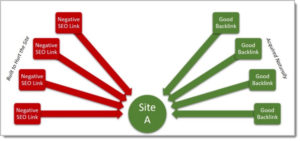If you found this article you probably understand the basics of negative SEO. And it’s likely you’re here because you believe your site has been targeted. Why? Two Words: Penguin Update
What is a Negative SEO Attack?
 Before we dive into Penguin we need to understand what negative SEO is and how it can affect a website. In short negative SEO is actions taken to hurt your website. It comes in many forms but the most common and easiest is when a competitor sends a bunch of bad / spam links to your site to make Google think you are the one practicing link schemes. This is the focus of this article, but there are many other forms of negative SEO such as mass posting bad reviews or even posting an entire site of bad content with tricky canonical tags. You can been hurt yourself with unintentional negative SEO by doing things like making your Google My Business profile too sales-pitchy or accidentally keyword stuffing your site.
Before we dive into Penguin we need to understand what negative SEO is and how it can affect a website. In short negative SEO is actions taken to hurt your website. It comes in many forms but the most common and easiest is when a competitor sends a bunch of bad / spam links to your site to make Google think you are the one practicing link schemes. This is the focus of this article, but there are many other forms of negative SEO such as mass posting bad reviews or even posting an entire site of bad content with tricky canonical tags. You can been hurt yourself with unintentional negative SEO by doing things like making your Google My Business profile too sales-pitchy or accidentally keyword stuffing your site.
How does Penguin Fight Back?
The Penguin update was launched in 2012 and helped and hurt a lot of sites. Far too many webmasters practiced link building practices that were easy and cheap if not free. At the time is seemed like a great idea. I’m helping your site and your helping mine. Unfortunately that is against Google’s best practices. A link should be given willingly because you have great interesting content. That’s the point and why Google focuses so much on links. They are essentially a vote from one site saying another should get better rankings. But if you are buying links or participating in other link schemes you’re gaming the system. Makes sense. Penguin focuses on your site’s link profile and if you got hit with a penalty you’d have to fix your negative SEO links and wait 6+ months for the next Penguin update. Nowadays Penguin works in real time so if you got hit you can recover fairly easily by updating your disavow file in Google Search Console (more on that in another post).
Bad Links
Once everyone knew Google was cracking down on bad links, evil SEOs out there started pointing bad links to their competitors. They wanted Google to think their competition was practicing these negative tactics and get penalized. That actually worked for a while. Fortunately Google is always learning and understands your entire site, link profile and can discern between links you intended and links you didn’t.
So Why Do We Have to Disavow?
One of the top guys at Google, John Meuller, said disavowing links is “something that you only really need to use in really extreme cases.” For instance if you have a manual penalty (How to tell if you have a manual penalty?) However you don’t want to wait for a manual penalty – you should be proactive and disavow your toxic links on a regular basis.
The Bottom Line on Negative SEO
In short you probably don’t have to worry about it and any traffic drops aren’t likely due to negative SEO. But, if you have seen a drop in traffic, sales, leads you should investigate. The easiest wasy to do that is give us a call for a free site audit. An SEO Consulatant here in Dallas is ready to help. We will tell you what might be impacting your traffic and rankings and advise on how to correct it. Again, for free…
